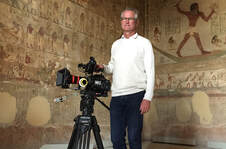Brody Neuenschwander

Brody Neuenschwander was born in Houston, Texas in 1958. He attended Princeton University, where he was appointed University Scholar, graduating in 1981 with high honors for his thesis on the techniques of medieval manuscript illumination. Neuenschwander completed his doctorate on the methodology of German art history in 1986 at the Courtauld Institute in London. At the same time he studied calligraphy at the Roehampton Institute. The cross-fertilization that resulted from doing academic and practical studies simultaneously has influenced all his subsequent work. The objects studied by art historians are, for Neuenschwander, things that were made by human hands. The structure of the atelier and the properties of the materials are as important to him as the social context of their creation.
Neuenschwander began his professional career as assistant to Donald Jackson, an English calligrapher living on the Welsh borders. For a year Neuenschwander did studio work, mostly traditional ceremonial pieces. In 1989 Neuenschwander met the English film director Peter Greenaway, who asked him to provide live-action calligraphy for the film “Prospero’s Books”. Greenaway asked pertinent and challenging questions: “Can calligraphy be charged with emotions and historical associations? Can it represent in visual terms sound patterns of the language? Can it explore the tense region between text and image?”
In subsequent collaborations (“The Pillow Book”, “Flying over Water”, “Bologna Towers 2000″, “Columbus”, “Writing to Vermeer” and so on) the implications of these questions for contemporary calligraphy would be worked out. In 1990 Neuenschwander met the German theoretician Hans-Joachim Burgert, whose analysis of the visual properties of calligraphy is essentially a classic German Gestaltungstheorie. Letterforms are subjected to formal analysis and judgment. Burgert replaces traditional Western standards of precision and regularity by a new formal language, one that is much closer to the esthetic judgments inherent in Arabic and Chinese calligraphy. Neuenschwander subsequently translated many of Burgert’s writings into English, which naturally allowed him to form a deeper understanding of Burgert’s theory and has led to this theory being studied and adopted by other calligraphers in the West.
For Neuenschwander this new theory was a revolution. Suddenly the calligraphy of the East, which had always exerted an enormous attraction, could be analyzed and understood, not linguistically, but visually. The image-nature of these writing systems could surface. Arabic and Chinese calligraphy have influenced his work ever since.
In recent years Neuenschwander has continued his studies of Arabic/Islamic and Chinese/Japanese calligraphy. In the project called “A Brush with Silence” calligraphers from the world’s many writing traditions are brought together for a silent calligraphic happening. Brody's latest television production was The Secret History of Writing aired all over the world to great critical acclaim.
Neuenschwander began his professional career as assistant to Donald Jackson, an English calligrapher living on the Welsh borders. For a year Neuenschwander did studio work, mostly traditional ceremonial pieces. In 1989 Neuenschwander met the English film director Peter Greenaway, who asked him to provide live-action calligraphy for the film “Prospero’s Books”. Greenaway asked pertinent and challenging questions: “Can calligraphy be charged with emotions and historical associations? Can it represent in visual terms sound patterns of the language? Can it explore the tense region between text and image?”
In subsequent collaborations (“The Pillow Book”, “Flying over Water”, “Bologna Towers 2000″, “Columbus”, “Writing to Vermeer” and so on) the implications of these questions for contemporary calligraphy would be worked out. In 1990 Neuenschwander met the German theoretician Hans-Joachim Burgert, whose analysis of the visual properties of calligraphy is essentially a classic German Gestaltungstheorie. Letterforms are subjected to formal analysis and judgment. Burgert replaces traditional Western standards of precision and regularity by a new formal language, one that is much closer to the esthetic judgments inherent in Arabic and Chinese calligraphy. Neuenschwander subsequently translated many of Burgert’s writings into English, which naturally allowed him to form a deeper understanding of Burgert’s theory and has led to this theory being studied and adopted by other calligraphers in the West.
For Neuenschwander this new theory was a revolution. Suddenly the calligraphy of the East, which had always exerted an enormous attraction, could be analyzed and understood, not linguistically, but visually. The image-nature of these writing systems could surface. Arabic and Chinese calligraphy have influenced his work ever since.
In recent years Neuenschwander has continued his studies of Arabic/Islamic and Chinese/Japanese calligraphy. In the project called “A Brush with Silence” calligraphers from the world’s many writing traditions are brought together for a silent calligraphic happening. Brody's latest television production was The Secret History of Writing aired all over the world to great critical acclaim.